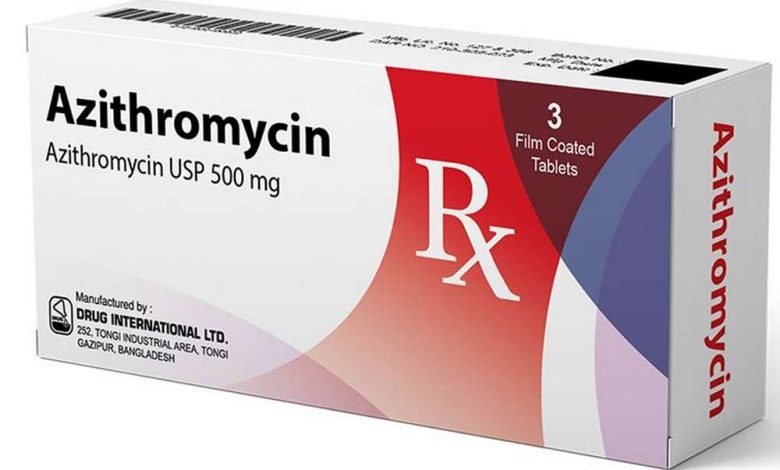Azithromycin: instructions for using the medicine, structure, Contraindications

When ATH:
J01FA10
Azithromycin: characteristic
The white crystalline powder.
Azithromycin: pharmachologic effect
Antibacterial.
Azithromycin: application
Infections of the upper (streptococcal pharyngitis and tonsillitis) and lower (bacterial exacerbation of chronic obstructive pneumonia, interstitial and alveolar pneumonia, Bacterial bronchitis) respiratory, ENT (otitis media, laringit e sinusitis), genitourinary system (urethritis and cervicitis), skin and soft tissue (mug, impetigo, secondarily infected dermatitis), chronic stage erythema migrans (Lyme disease).
Azithromycin: Contraindications
Hypersensitivity (incl. to other macrolides).
Azithromycin: restrictions on use
Serious liver and kidney, pregnancy, lactation.
Azithromycin: use during pregnancy and lactation
Maybe, if the effect of therapy outweighs the potential risk to the fetus and child.
Category actions result in FDA - B. (The study of reproduction in animals revealed no risk of adverse effects on the fetus, and adequate and well-controlled studies in pregnant women have not done.)
Azithromycin: side effects
Nausea, vomiting, diarrhea, constipation, flatulence, abdominal pain, ground, cholestatic jaundice, chest pain, heartbeat, weakness, headache, dizziness, drowsiness, jade, vaginitis, neutropenia or neutrophilia, psevdomembranoznыy colitis, candidiasis, photosensitivity, rash, angioedema, eozinofilija; children, Besides, giperkineziya, excitation, nervousness, insomnia, conjunctivitis.
Azithromycin: interaction
It enhances the effect of ergot alkaloids, digidroэrgotamina. Tetracyclines and chloramphenicol-reinforcing effect (synergism), lincosamides is reduced effect. Antacids, ethanol, food slow down and reduce absorption. Slows excretion, increases serum concentration and enhances the toxicity of cycloserine, anticoagulants, methylprednisolone and felodipine. By inhibiting microsomal oxidation in hepatocytes, lengthens T1/2, slows excretion, increases the concentration and toxicity of carbamazepine, ergot alkaloids, valproic acid, geksoʙarʙitala, phenytoin, dizopiramida, bromocriptine, Theophylline and other xanthine derivatives, oral hypoglycemic agents. Incompatible with heparin.
Azithromycin: Dosing and Administration
Inside (for 1 hours before or after 2 hours after meals), taking 1 once a day. Adults with infections of the upper and lower respiratory tract, infections of skin and soft tissues — in the first day- 0,5 g, from 2-nd to 5th day- 0,25 g / day, or 0,5 g / day for 3 days (dose rate- 1,5 g).
In obstetric diseases — 1 g once; When Lyme disease is 1 g on the first day, from 2-nd to 5th day-on 500 mg (dose rate- 3 g).
Children over 12 on the first day of the month is 10 mg / kg, then 4 -on 5 mg/kg or 10 mg/kg/day for 3 days (dose rate- 30 mg / kg); When Lyme disease on the first day — 20 mg / kg, from 2-nd to 5th day- 10 mg / kg / day.
Azithromycin: precautions
It is necessary to observe the break 2 h in case of simultaneous use of antacids. Use caution when expressed violations of the liver, kidney, cardiac arrhythmias (ventricular arrhythmias and QT prolongation). After discontinuation of treatment hypersensitivity reactions in some patients may persist, which require a specific therapy under the supervision of a physician.
Azithromycin: interaction with other drugs
| Active substance | Description of interaction |
| Algeldrat + Magnesium hydroxide | FKV. Slows absorption (the interval between doses should be at least 2 no). |
| Aminofillin | FKV. Against the background of azithromycin (blocks biotransformation) increased serum concentration. |
| Bromocriptine | FKV. FMR. Against the background of azithromycin (inhibits microsomal oxidation) elongates T1/2, slows excretion, increasing the concentration in blood and the risk of toxicity. |
| Warfarin | FKV: synergism. Against the backdrop of increased anticoagulant effect of azithromycin. |
| Digoxin | FKV. Increases in serum; the combined use caution. |
| Carbamazepine | FKV. FMR. Against the background of azithromycin (inhibits microsomal oxidation) elongates T1/2, slows excretion, increasing the concentration in blood and the risk of toxicity. |
| Magnesium oxide | FKV. Reduce the speed and completeness of absorption, lowers Cmax and time to achieve it, but it does not affect the AUC; joint application should be avoided. |
| Methylprednisolone | FKV. FMR. Against the background of azithromycin slows excretion, increases the concentration in the blood and increases the risk of toxicity. |
| Nevirapine | FKV. Against the background of azithromycin (slows the biotransformation) increases the equilibrium concentration in plasma. |
| Nelfinavir | FKV. Against the background of azithromycin reduced (about 15% — There is no need to adjust the dose) AUC of the drug and its metabolite M8. |
| Rifabutin | FMR. Strengthens (mutually) effect; described a severe neutropenia and leukopenia, provoked by the combined use of. |
| Theophylline | FKV. FMR. Against the background of azithromycin (inhibits microsomal oxidation) increases T1/2, slows excretion, increasing the concentration in the tissues, the effect is enhanced and the risk of toxicity. |
| Felodipine | FKV. FMR. Against the background of azithromycin slows excretion, increases the concentration in the blood and increases the risk of toxicity. |
| Phenytoin | FKV. FMR. Against the background of azithromycin (inhibits microsomal oxidation) elongates T1/2, slows excretion, increasing the concentration in blood and the risk of toxicity. |
| Chloramphenicol | FMR: synergism. Strengthens (mutually) antibacterial effect. |
| Cycloserine | FKV. FMR. Against the background of azithromycin slows excretion, increases the concentration in the blood and increases the risk of toxicity. |
| Cyclosporine | FKV. Against the background of azithromycin (inhibits CYP450) zamedlyaetsya biotransformation, increases in serum; the combined appointment of caution. |
| Ergotamin | FMR. Against the background of azithromycin increased the likelihood of acute poisoning; combined appointment requires caution. |
| Ethanol | FKV. It slows down and reduces the absorption of. |
